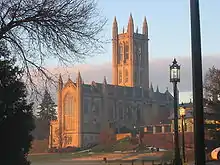Trinity College (Connecticut)
Trinity College is a private liberal arts college in Hartford, Connecticut. Founded as Washington College in 1823, it is the second-oldest college in the state of Connecticut.
 | |
Former names | Washington College (1823–1845) |
|---|---|
| Motto | Pro Ecclesia Et Patria (Latin) |
Motto in English | For Church and Country |
| Type | Private liberal arts college |
| Established | May 1823 |
| Endowment | $615 million (as of June 30, 2018)[1] |
| President | Joanne Berger-Sweeney |
| Vice-president | Michael T. Casey |
| Dean | Sonia Cardenas |
Academic staff | 298 (Fall 2018)[2] |
| Students | 2,198 (Spring 2021)[3] |
| Undergraduates | 2,098 (Spring 2021)[3] |
| Postgraduates | 91 (Spring 2021)[3] |
| Location | , United States |
| Campus | Urban, 100 acres (40 ha) |
| Colors | Blue and old gold |
| Athletics | NCAA Division III – NESCAC |
| Nickname | Bantams |
| Affiliations | CIC, Annapolis Group, Oberlin Group, CLAC, Space-grant |
| Sports | 29 varsity teams[4] |
| Mascot | Bantam |
| Website | www |
Coeducational since 1969, the college enrolls 2,235 students.[3] Trinity offers 41 majors and 28 interdisciplinary minors.[5] The college is a member of the New England Small College Athletic Conference (NESCAC).
History
Early history
.jpg.webp)
Early Connecticut was dominated by Congregationalists. Episcopalians, who had long sought to set up their own college, were provided an opportunity when the Connecticut Constitution disestablished the Congregationalist Church in 1818. It was taken by Bishop Thomas Brownell, who opened Washington College in 1824 to nine students[6] and the vigorous protest of Yale alumni. A 14-acre site was chosen, at the time about a half-mile from the city of Hartford. Over time Bushnell Park was laid out to the north and the east, creating a beautiful space.[7]
The college was renamed Trinity College in 1845; the original campus consisted of two Greek Revival buildings. One of the Greek Revival buildings housed a chapel, library, and lecture rooms. The other was a dormitory for the male students who attended the college.[8]
The site next to Bushnell Park, where Trinity College then stood, was deemed an ideal location for building a statehouse.[7] So the trustees were persuaded to sell the entire campus to the city in 1872 for $600,000.[7] The trustees moved the college to an 80-acre site on a ridge on the western edge of Hartford.[7] Then-president Abner Jackson hired an English architect to draw up plans for an entire campus.[7] Construction of the new campus was begun under the presidency of Thomas Ruggles Pynchon (1874–1883).[7]
New campus
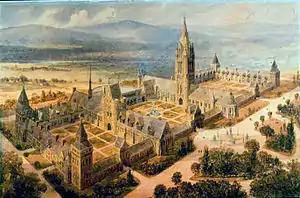
In 1872, Trinity College was persuaded by the state to move from its downtown "College Hill" location (now Capitol Hill, site of the state capitol building) to its current 100-acre (40 ha) campus a mile southwest. Although the college sold its land overlooking the Park River and Bushnell Park in 1872, it did not complete its move to its Gallows Hill campus until 1878.[9] The original plans for the Gallows Hill site were drawn by the noted Victorian architect William Burges but were too ambitious and too expensive to be fully realized. Only one section of the proposed campus plan — the Long Walk— was completed.
By 1889 the library contained 30,000 volumes, and the school boasted over 900 graduates.[7] Enrollment reached 122 in 1892. President Remsen Ogilby (1920–43) enlarged the campus, and more than doubled the endowment. The faculty grew from 25 to 62, and the student body from 167 to 530 men. Under President Keith Funston (1943–51), returning veterans expanded the enrollment to 900.[6]
Twentieth century
Trinity ended the nineteenth century as an institution primarily serving the Hartford area. The early years of the century were primarily growth years for Trinity. Enrollment was increased to 500 men.
In 1932, under President Remsen Ogilby, the Gothic chapel was completed and became the symbol of Trinity College. It replaced the Seabury chapel which had become too small for the student body.
The founding of the University of Hartford in 1957 allowed Trinity to focus on becoming a regional institution rather than a local one.
In 1962, Connecticut Public Television (CPTV) began its first broadcasts in the Trinity College Public Library, and later in Boardman Hall, a science building on campus.[10][11]
In 1968, the trustees voted to withdraw from the Association of Episcopal Colleges.[12]
Also in 1968, the trustees of Trinity College voted to make a commitment to enroll more minority students, providing financial aid as needed. This decision was preceded by a siege of the administrative offices in the Downes and Williams Memorial buildings during which Trinity students would not allow the president or trustees to leave until they agreed to the resolution.[13]
Less than one year later, Trinity College became coeducational and admitted its first female students, as transfers from Vassar College and Smith College.[14] Today, women make up about 50 percent of Trinity's student body.
Academic regalia
Trinity followed the European pattern of using academic regalia from its foundation,[15] and was one of only four US institutions (all associated with the Episcopal Church) to assign gowns and hoods for its degrees in 1883.[16] There were six degrees awarded at the time, all taking a black gown of silk or stuff and a hood of black silk lined according to the degree: BA white silk, MA dove-colored silk, BD crimson silk, DD scarlet silk, LLD pink silk, MusD purple silk.[16]
In 1894, a year before the introduction of the intercollegiate code on academic costume, the college brought in a new scheme of academic regalia. The hoods and gowns followed the shape of those used at the University of Oxford except that the hood for Doctors of Divinity was of the shape used at the University of Cambridge. A variety of different colours and fabrics were used for the hoods: BA black stuff edged palatinate purple, BS black stuff edged light blue silk, BLitt black stuff edged russet brown silk, BD black silk edged scarlet silk (not in use by 1957), LLB black silk edged dark blue silk (not in use by 1957), MusB black silk edged pink silk (not in use by 1957), MA black silk lined palatinate purple silk, MS black stuff lined light blue silk, DD scarlet cloth lined black silk, DLitt scarlet silk-lined russet brown silk, LLD scarlet silk lined dark blue silk, DCL crimson silk lined black silk, MusD white silk-lined pink silk, DSc black silk lined light blue silk, PhD black silk lined people silk (not in use by 1957), MD scarlet silk lined maroon silk (not in use by 1957).[15][17] To this were added DPH black cloth lined salmon pink silk (1945), DHLitt scarlet silk-lined people silk (1947), DHum white silk-lined crimson (1957), and DST scarlet silk-lined blue with a gold chevron (1957).[15] As of 2018, the hoods for doctorates (except the PhD and MD) and for the MMus remain in use for honorary degrees, with the further addition since 1957 of the DFA wrote lined white with a red Chevron.[18]
Academics

Trinity offers three degrees: the B.A., B.S., and M.A. (in a few subjects). The college offers 41 majors, as well as the options of creating a self-designed major or adding an interdisciplinary or departmental minor. Trinity is part of a small group of liberal arts schools that offer degrees in engineering. Trinity has a student-to-faculty ratio of 9:1.[19]
Trinity College, Rome Campus
Trinity College, Rome Campus (TCRC), is a study abroad campus of Trinity College. It was established in 1970 and is in a residential area of Rome on the Aventine Hill close to the Basilica of Santa Sabina within the precincts of a convent run by an order of nuns.[20]
Admissions

The 2020 annual ranking by U.S. News & World Report categorizes Trinity as "more selective".[21]
For the Class of 2022 (enrolling fall 2018), Trinity received 6,096 applications, accepted 2,045 (33.5%) and enrolled 579.[22]
As of fall 2015, Trinity College does not require the SAT or ACT for students applying for admission.[23] Of the 31% of enrolled freshmen submitting SAT scores, the middle 50% range was 630–710 for evidence-based reading and writing, and 670–750 for math, while of the 23% of enrolled freshmen submitting ACT results, the middle 50% range for the composite score was 29–32.[22]
Rankings and reputation
| University rankings | |
|---|---|
| National | |
| Forbes[24] | 109 |
| THE/WSJ[25] | 87 |
| Liberal arts colleges | |
| U.S. News & World Report[26] | 44 |
| Washington Monthly[27] | 20 |
Trinity is known as one of the Little Ivies.[28] U.S. News & World Report ranked Trinity tied for 46th in its 2020 ranking of best national liberal arts colleges in the United States. It was also ranked 49th for best value school.[29] Additionally, College Choice ranked Trinity 19th among best national liberal arts colleges.[30] However, the college joined the "Annapolis Group" in August 2007, an organization of more than 100 of the nation's liberal arts schools, in refusing to participate in the magazine's rankings.[31]
The Wall Street Journal has ranked Trinity as one of the 50 best feeder schools in the nation for top graduate school programs.[32] Data compiled by the National Science Foundation lists Trinity as a liberal arts college that graduates disproportionately high numbers of future scientists.
In 2016, authors Howard and Matthew Greene continued to include Trinity in the third edition of Hidden Ivies: 63 Top Colleges that Rival the Ivy League.[33] In addition, The Princeton Review has given Trinity a 92 (out of 99) for selectivity and in 2017 named Trinity as a best value college. In 2018, Forbes magazine ranked Trinity College 89th in the country and 35th for best liberal arts universities. TIME magazine ranked Trinity College 84th among all colleges and universities in the nation.[34][35]
Student life
The bantam

Trinity's mascot, the bantam, was conceived by Joseph Buffington, class of 1875, who was a federal judge and trustee of the college.[36]
Alma mater
Trinity's alma mater is "’Neath the Elms." It was written in 1882 by Trinity student Augustus P. Burgwin to the tune of a song that his butler often sang. When "'Neath the Elms" was written, the college had been planting elm trees on the quad, which remain today.
Student publications
Athletics
The Trinity College Department of Athletics currently sponsors a wide range of sports.
Fraternities and sororities
Officially, approximately 18% of the student body are affiliated with a Greek organization.[37] They operate under guidelines and regulations established and enforced by the Trinity College.
In 2012, then-president James F. Jones proposed a social policy for Trinity College which made a commitment, among other things, to require all sororities and fraternities to achieve gender parity within two years (i.e., for each sorority and fraternity to have an equal number of male and female members) or face closure. Trinity College's co-ed mandate for fraternities and sororities was withdrawn in September 2015 and replaced with the "Campaign for Community" effort to establish more inclusive social traditions on campus.[38]
Trinity currently has the following sororities and fraternities:[39]
- Alpha Chi Omega was founded as the Order of the Elms in October 2016. Received affiliation with the NPC in May 2017.
- Alpha Chi Rho (Crow) was founded at Trinity College in 1895
- Alpha Delta Phi (AD)
- Alpha Epsilon Pi (AEPi) Tau Beta Chapter
- Alpha Kappa Alpha (AKA)
- Cleo of Alpha Chi (Cleo)
- Kappa Kappa Gamma
- Kappa Sigma
- Lambda Alpha Upsilon
- Lambda Pi Upsilon (LPiU)
- Pi Kappa Alpha (Pike)
- Psi Upsilon (Psi U)
- St. Anthony Hall (The Hall or St. A's)
- The Stella Society : founded at Trinity College in 2017
- Zeta Omega Eta: founded at Trinity College in 2003.
Hartford campus

Long Walk buildings
The first buildings completed on the current campus were Seabury and Jarvis halls in 1878. Together with Northam Towers, these make up what is known as the "Long Walk". These buildings are an early example of Collegiate Gothic architecture in the United States, built to plans drawn up by William Burges, with F.H. Kimball as supervising architect. The Long Walk has been expanded and is connected with several other buildings. On the northernmost end there is the chapel, whose western side is connected to the Downes and Williams Memorial building. Heading south, the next building is Jarvis Hall, named after Abraham Jarvis. Jarvis becomes Northam Towers heading south, then Seabury Hall. Seabury Hall, named for Samuel Seabury, is connected to Hamlin Hall. To Hamlin's east is Cook, then Goodwin and then Woodward. The dormitories on the Long Walk end there, and the terminal building on the south end of the long walk is Clement/Cinestudio. Clement is the chemistry building; Cinestudio a student run movie theater. If one travels to the south of Hamlin there will be Mather Hall and the Dean of Students Office.[40]
Chapel
The Trinity College Chapel was built in the 1930s to replace Trinity's original chapel in Seabury Hall (now a lecture hall). The chapel's facade is made almost entirely of limestone and connects to the adjacent Downes Memorial Clock Tower. Its primary architect was Philip Hubert Frohman, of Frohman, Robb and Little, who were also responsible for the National Cathedral in Washington, DC.
Main quadrangle

Trinity's campus features a central green known as the Main Quad, designed by famed architect Frederick Law Olmsted. The large expanse of grass is bound on the west by the Long Walk, on the east by the Lower Long Walk, on the north by the chapel, and on the south by the Cook and Goodwin-Woodward dormitories. While a central green is a feature of many college campuses, Trinity's is notable for its unusually large, rectangular size, running the entire length of the Long Walk and with no walkways traversing it. Trees on the Quad have been planted in a 'T' configuration (for Trinity) with the letter's base at the statue of Bishop Brownell (built 1867).[41] and its top running the length of the Long Walk. Tradition holds that the trees were intended to distinguish Trinity's campus from Yale's. Also on the Quad are two cannons used on the USS Hartford, flagship of Admiral David Farragut during the American Civil War.

The whole of Trinity's campus is set out on a 100-acre (40 ha) parcel of land that is bound on the south by New Britain Avenue, on the west by Summit Street, on the east by Broad Street, and on the north by Allen Place. Trinity's former northern border, Vernon Street, has been transferred from the city of Hartford to Trinity College and closed off at one end (Broad Street), creating a cul-de-sac within Trinity's borders. Completed in 2001, and on what was formerly an abandoned bus depot adjacent to Trinity's campus, the Learning Corridor is a collection of K-12 public magnet schools co-created by Trinity and the governments of Hartford and Connecticut.
Other important buildings on campus

- Albert C. Jacobs Life Sciences Center – Built in 1967 in the architectural style of Brutalism, the Life Science Center, or LSC, was designed to be an abstract representation of the Long Walk. The building houses Trinity's departments of Biology and Psychology. It contains several classrooms, an auditorium, teaching labs, research labs, and a greenhouse. Trinity's first dedicated neuroscience lab is to be built in LSC in 2011. Fund raising is underway to construct a neuroscience suite and a music rehearsal hall on the north side of LSC.

- Austin Arts Center – The AAC was designed in the 1960s, and contains art exhibition spaces, two theaters (Garmany and Goodwin), a few classrooms, and is home to the offices of Theater and Dance and Music professors.
- Clement - The Clement Center, is home to the Chemistry department. Clement contains four teaching laboratories, eight research laboratories, instrument rooms, computer rooms, and classrooms. It also offers its own library, conducive to scholarly pursuits and thoughtful concentration. During the summer of 2011, the building underwent a $750,000 renovation of five of its laboratories through funds provided by the National Science Foundation. Clement is also home to Cinestudio, the on campus movie theater.
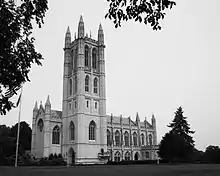
- Chapel The Trinity College Chapel was built in 1933. It was designed by Frohman, Robb and Little, the same architects who designed the National Cathedral in Washington, DC. The chapel is home to various religious services, as well as the service of Nine Lessons and Carols, a long-standing tradition at Trinity. The chapel is the tallest point in the city of Hartford.
- Facilities (formerly Buildings and Grounds) The facilities building is the home of various departments that relate to the maintenance of the physical (as opposed to the academic) aspects of the college. Included in this building is the Director of Facilities, the Superintendent of Grounds, the Superintendent of Construction Trades (who is also the Superintendent of Access Control), various engineers, electricians, painters, carpenters and mechanics.
- Ferris Athletic Center*- Ferris Athletic Center includes a field house, an eight-lane, 37-meter swimming pool with a movable bulkhead, 16 international-size squash courts, two basketball courts, 2 weight rooms (Rick and Anne Hazelton Fitness Center), one of which that is new and used for varsity team athletes, two crew tanks, a wrestling room and a 1/10-mile indoor track. It was named after George M. Ferris, who graduated Trinity. Adjacent to Ferris are 19 acres of playing fields for soccer, lacrosse, field hockey, and baseball as well as the multi- purpose Robin L. Sheppard Field and the 6,500- seat Dan Jessee/Don Miller Football Field and Track.
- Jarvis Hall – This section of the Long Walk contains single, double and quad dorms, primarily for juniors and seniors. It is rumored that the doubles were originally designed for students while the singles across the hallway were intended for their servants. In actuality, the single rooms were single bedrooms, which opened into living areas, which are currently the doubles and the hallway, and six rooms retain this layout. As of the 2008 school year, the massive Long Walk Reconstruction project has been completed, and the dorms are built in a classic style.
- Mather Hall – Just south of Hamlin Hall (the southern terminus of the long walk), Mather Hall is the main student center of Trinity College. The building contains the main dining hall as well as "The Cave" dining hall, a post office and student mail boxes, a coffee house, as well as meeting rooms and large auditoriums.
- Koeppel Community Sports Center – Completed in 2006, the $15.5 million center serves as Trinity's ice hockey arena. The Koeppel Center also serves as a recreational center for students and is open to the public. The Koeppel Center was given a prestigious design recognition as part of the "Facilities of Merit" awards in 2007.[42]
- Roy Nutt Mathematics, Engineering & Computer Science Center – is on the Life Sciences Quad (named for the Life Sciences Center, which dominates the eastern side of the quad) it is made of brick and sandstone. The Nutt Center was designed by renowned architect César Pelli.[43]
- Northam Towers – This central tower on the Long Walk, flanked by the Fuller archway, connects Jarvis and Seabury Halls. The towers contain student housing. The National Fraternity of Alpha Chi Rho was founded in a room within Northam Towers.

- North Campus Hall - The largest dormitory on Trinity's campus was completed in 1958. The building has since been renovated various times, and spans the trajectory of two streets, from Vernon Street to Allen Place. It is a two-story building with long hallways and multiple common rooms.[44]
- Raether Library and Information Technology Center – Trinity's main library was originally built at the southeast corner of the main quad in the 1950s to replace the library in Williams Memorial. Additional wings were constructed in the 1970s, and a major renovation took place in 2002, at which time the building was given its present name. The Watkinson Library, which houses rare books and manuscripts, occupies an annex of the first floor. The latest renovations, which enlarged the facility to 172,000 square feet (16,000 m2) and more than 1 million volumes, include an atrium, grand reading room, three new computing labs, a multimedia development studio, a music and media center, private study rooms, and a cafe. Though a private academic library, more than 2,800 outside visitors were recorded between November, 2006 and March, 2007.
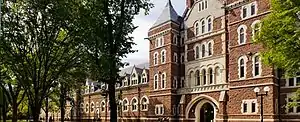
- Seabury Hall – This section of the Long Walk contains classrooms, professor's offices, and four dance studios. Its recent $32.7 million renovation project was completed in 2008. In addition, the old Seabury chapel was renovated into a classroom, maintaining the pews for student seating.
- Trinity Commons * – on the south end of campus on New Britain and Summit St., Trinity Commons is the new arts mecca on campus. It is contains 4 studio classrooms and the newly constructed Performance Lab. The Performance Lab is a massive black box theater that can sit at least 100 people, but can accommodate much more with standing room. It has a set lighting plot with about 100 lights and is the new performance venue for most new student and faculty shows. It also houses many offices on the other side of the building. It is one of the newest buildings on campus and only houses Theater and Dance classes and administrative offices.
- Vernon Social Center – Vernon Social Center, on Vernon Street, is a multipurpose auditorium used on campus for various events, including concerts and lectures. It is attached to Vernon Place, a dormitory, and makes up the quad housing North Campus Hall and High Rise Hall.
Film
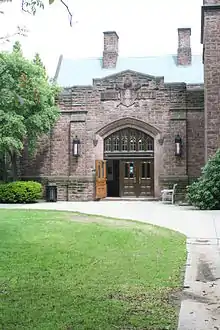
Cinestudio is an art cinema with 1930s-style design. An article in the Hartford Advocate described this non-profit organization, which depends solely on grants and the efforts of volunteer workers who are paid in free movies.[45] Cinestudio has been in the Clement Chemistry Building since it was founded in the 1970s.
Music
Trinity also hosts the annual Trinity International Hip Hop Festival. A three-day celebration of global hip hop culture, the festival features lectures, panel discussions, workshops and live performances. The festival was founded in 2006 with the goal of unifying Trinity with the city of Hartford.[46]
Since 2006, the station has broadcast the Trinity Samba Fest from the Hartford waterfront featuring regional and international talent.[47][48][49]
Notable alumni
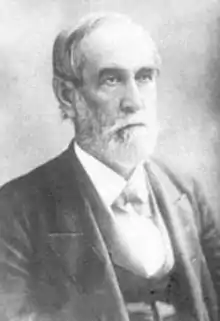
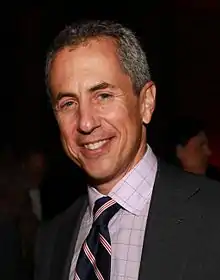


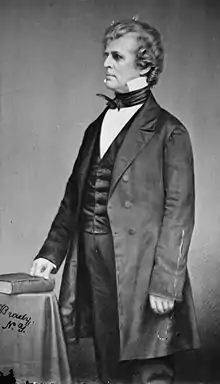


Among Trinity College's distinguished alumni include many influential and historical people, including five governors, US Cabinet members, federal judges, political commentators and journalists, and senior executives in business and industry.
Notable alumni of Trinity College include:
- Kristine Belson, president of Sony Pictures Animation and Oscar-nominated film producer (The Croods)
- S. Prestley Blake, co-founder of Friendly's
- Joseph Buffington, judge, United States Court of Appeals for the Third Circuit
- Tucker Carlson, political commentator, host of Fox News Channel's Tucker Carlson Tonight
- Tom Chappell, founder of Tom's of Maine
- Martin W. Clement, President of the Pennsylvania Railroad Company, 1935 to 1948.
- Percival W. Clement, 57th Governor of Vermont
- Thomas R. DiBenedetto, president of Boston International Group, owner and former chairman of AS Roma
- David Gottesman, billionaire, founder of First Manhattan Co., and member of Berkshire Hathaway's board of directors
- Henry McBride, 4th Governor of Washington State
- Mary McCormack, actress (In Plain Sight, The West Wing). Her two siblings are also Trinity graduates. Bridget McCormack is Chief Justice of the Michigan Supreme Court, and Will McCormack is an actor.
- Mitchell M. Merin, former president and chief operating officer of Morgan Stanley Investment Management
- James Murren, chairman of the board and chief executive officer of MGM Resorts International
- Charles R. Perrin, chairman of Warnaco, former chairman and CEO of Avon Products and of Duracell
- Rachel Platten, singer-songwriter
- William C. Richardson, board director of Exelon; former president of Johns Hopkins University
- Jane Swift, Class of 1987, former Governor of Massachusetts
- J. H. Hobart Ward, US Army general
- Jesse Watters, conservative commentator and host of Watters World and co-host of The Five on Fox News
- John Williams, eleventh presiding bishop of the Episcopal Church in the United States
- Charles C. Van Zandt, 34th Governor of Rhode Island
References
- As of June 30, 2019. "U.S. and Canadian 2019 NTSE Participating Institutions Listed by Fiscal Year 2019 Endowment Market Value, and Percentage Change in Market Value from FY18 to FY19 (Revised)". National Association of College and University Business Officers and TIAA. Retrieved April 23, 2020.
- "Common Data Set 2018–2019, Part I" (PDF). Trinity College.
- "Common Data Set 2018–2019, Part B" (PDF). Trinity College.
- "Schools". NCAA.com. Archived from the original on 2016-03-04. Retrieved 2018-04-03.
- "Majors and Minors". Trinity College. Trinity College. Retrieved 2020-05-21.
- Albert E. Van Dusen, Connecticut" (1961) pp 362-63
- Hartford, Conn., as a manufacturing, business and commercial center; with brief sketches of its history, attractions, leading industries, and institutions . Hartford, CT: Hartford (Conn) Board of Trade. 1889. pp. 182–187. Retrieved 1 September 2016.
- Albert E. Van Dusen, Connecticut" (1961) pp 362–63
- "Trinity College". Trincoll.edu. Archived from the original on January 10, 2011. Retrieved January 24, 2011.
- "Our History | Connecticut Public Broadcasting Network". Cpbn.org. Retrieved 2014-08-17.
- "CPTV Celebrates 50 Years: Present at the Creation - Connecticut Magazine - April 2013 - Connecticut". Connecticutmag.com. 1962-10-01. Retrieved 2014-08-17.
- Knapp, Peter J. (Peter Jonathan), 1943- (2000). Trinity College in the twentieth century : a history. Knapp, Anne H. Hartford, Conn.: Trinity College. p. 209. ISBN 0-911534-59-8. OCLC 45273021.CS1 maint: multiple names: authors list (link)
- "Exit Interview with Dr. Theodore Davidge Lockwood". Trinity College Digital Repository. Retrieved 8 July 2019.
- Carlesso, Jenna. "Former Trinity College president, known for admitting the school's first female students, dies". Hartford Courant. Retrieved 8 July 2019.
- Academic Costume. Trinity College Bulletin. May 1957. p. 7.
- T. W. Wood (1883). The degrees, gowns and hoods of the British, Colonial, Indian and American universities and colleges. Thomas Pratt and Sons, London. pp. 31–36.
- C. A. Ealand, ed. (1920). Athena. Macmillan, New York. p. 118.
- "Commencement Program" (PDF). 2018. p. 34. Retrieved 16 May 2020.
- "Overview". U.S News Best Colleges. U.S. News. Retrieved 2020-05-21.
- "The Trinity College Rome Campus". trincoll.edu.
- "Trinity College". U.S. News & World Report. Retrieved May 21, 2020.
- "Common Data Set 2018–2019, Part C" (PDF). Trinity College.
- "Application Process". Trinity College. Retrieved May 21, 2020.
- "America's Top Colleges 2019". Forbes. Retrieved August 15, 2019.
- "Wall Street Journal/Times Higher Education College Rankings 2021". Wall Street Journal/Times Higher Education. Retrieved October 20, 2020.
- "Best Colleges 2021: National Liberal Arts Colleges". U.S. News & World Report. Retrieved September 24, 2020.
- "2020 Liberal Arts Rankings". Washington Monthly. Retrieved August 31, 2020.
- "Little Good News for the Little Ivies - Bloomberg Businessweek". Bloomberg. 2016-12-22. Archived from the original on 2020-01-03.
- "National Liberal Arts Colleges - Trinity College". U.S. News & World Report. September 11, 2019.
- "Best National Liberal Arts Colleges". April 6, 2015.
- "Trinity College". Trincoll.edu. August 16, 2007. Archived from the original on December 6, 2010. Retrieved January 24, 2011.
- Archived November 22, 2011, at the Wayback Machine
- Greene, Howard; Greene, Matthew (2016). The Hidden Ivies, 3rd Edition: 63 of America's Top Liberal Arts Colleges and Universities. HarperCollins. ISBN 978-0062420909.
- "America's Top Colleges". Forbes. September 12, 2018.
- "711 Best Colleges For Your Money". TIME. April 7, 2017.
- Archived September 22, 2009, at the Wayback Machine
- e. "Trinity College - College Facts". Trincoll.edu. Archived from the original on 2016-03-04. Retrieved 2015-08-16.
- "Important Message about Student Life". trincoll.edu. Archived from the original on 2017-09-30. Retrieved 2015-10-16.
- "Organizations". Trinity College (Connecticut). Retrieved 30 May 2018.
- Thomas, Grace Powers (1898). Where to educate, 1898-1899. A guide to the best private schools, higher institutions of learning, etc., in the United States. Boston: Brown and Company. p. 26. Retrieved August 17, 2012.
- Archived May 26, 2012, at the Wayback Machine
- "A Brief History of Campus Planning at Trinity". trincoll.edu. Archived from the original on 2016-03-03.
- Knapp, Peter J., and Anne H. Knapp. Trinity College in the twentieth century: a history. Hartford, Conn.: Trinity College, 2000.
- "About". Cinestudio. September 25, 2008. Retrieved January 24, 2011.
- "World hip-hop questions US rap". 2006-04-29. Retrieved 2019-11-21.
- "Samba Fest" (Press release). Trinity College.
- Hamad, Michael (April 30, 2015). "Samba Fest: A Day Of Brazilian Culture, Music, Food". Hartford Courant.
- Boyer, Brian & Dell, Barbara Glassman. "Ninth Annual Samba Fest at Hartford Riverfront, May 2". MetroHartford Alliance.CS1 maint: uses authors parameter (link)
